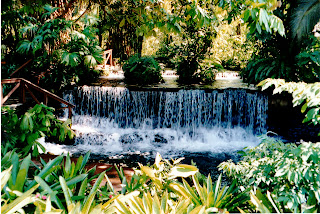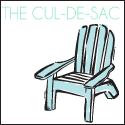In honor of Censational Girl's "Favorite Destinations" link party today, I thought I would share a (rather lengthy) travel piece I wrote six years ago about our Costa Rican adventure. Some of the pictures are my own; the others are credited. Happy Dreams!
Costa Rican Dreamin' on a Winter's Day
The clock strikes two on a February afternoon, and as my mascara melts off my already-sunburned face, I begin to doubt. Why did I choose a Costa Rican holiday, when I can perspire to my skin’s content back home in Texas?
 |
| via |
Blaming the altitude and humidity for my fatigue and glistening forehead, I retreat to the hammock on my balcony and collapse. Shaded by banana trees, orchids, hydrangea, bougainvillea, and azaleas, I sip an expertly concocted sangria and let the floral perfumes envelope me, before drifting to sleep, dreaming of the ten days ahead….
At sunrise, the innkeepers’ green-eyed cat awakens us, having entered our room through an open window. We dine on a traditional Tico breakfast of eggs, plantains, fried cheese, rice, beans, and tortillas before departing for the Arenal Volcano Region. En route, the pastoral landscape — fertile green valleys sandwiched between mountain ranges, roaming livestock, narrow roads winding between villages — reminds us of Switzerland. Despite it being the dry season, we are surrounded by emerald grasses and flowers of hues so exotic that you’d have to peruse the giant 120-box of Crayons to find close, but still imprecise, matches. We stop to admire the whimsical topiary gardens in Zarcero, the artisan offerings of Sarchi. We drive for four hours, noting the absence of road signs and wondering, but not minding, if we’re lost.
The conical tower looming ahead signals our arrival in La Fortuna, a sleepy farming town at the base of the incessantly erupting Arenal Volcano. We lunch at an outdoor steakhouse, El Novillo, where generous portions of filet mignon, fried yucca, local beer, and volcano views set us back a mere $20. After lunch, we hike at Arenal National Park, climbing over lava rock, listening to chatty toucans, and oohing and aahing at the bursts of steam from the cone overhead, before reaching what will be one of several miradors we enjoy on this trip — a panoramic view of man-made Laguna de Arenal, Costa Rica’s largest lake.
This night and the next, we sleep in air-conditioned comfort at Tabacón Hot Springs Resort, an upscale hotel in the volcano’s backyard. What Tabacón lacks in character it compensates in convenience. Our room, a standard king, boasts floor-to-ceiling windows with a direct volcano view, a large balcony, furnishings crafted by Costa Rican artists, and a modern bath. Tabacón hotel guests enjoy extended privileges at the hot springs and spa as well as manicured tropical grounds, complimentary buffet breakfasts, and an affable concierge who arranges the best in local excursions. On our first afternoon at the hot springs, we sample seven pools, each heated by nature to a different temperature. The crowd, a jovial mix of spring-breakers, backpackers, honeymooners, and retirees, dissipates by early eve, and we enjoy the hot springs in solitude until the moon shines overhead and exhaustion prevails.
This night and the next, we sleep in air-conditioned comfort at Tabacón Hot Springs Resort, an upscale hotel in the volcano’s backyard. What Tabacón lacks in character it compensates in convenience. Our room, a standard king, boasts floor-to-ceiling windows with a direct volcano view, a large balcony, furnishings crafted by Costa Rican artists, and a modern bath. Tabacón hotel guests enjoy extended privileges at the hot springs and spa as well as manicured tropical grounds, complimentary buffet breakfasts, and an affable concierge who arranges the best in local excursions. On our first afternoon at the hot springs, we sample seven pools, each heated by nature to a different temperature. The crowd, a jovial mix of spring-breakers, backpackers, honeymooners, and retirees, dissipates by early eve, and we enjoy the hot springs in solitude until the moon shines overhead and exhaustion prevails.
Early the next morning, we meet our native guide for a half-day horseback ride to and from the Rio Fortuna Waterfalls. My horse, Titi, humors my novice riding skills as I navigate yucca fields, cow pastures, and rocky streams before arriving at the waterfalls entrance. From there, a steep descent on stone steps takes us to the base of the falls and its clear swimming pools. The swim refreshes, but too soon, we are climbing back up — it is a taxing 25-minute ascent — to our horses and riding back to town. At the stables, our guide introduces us to his children, handsome boys who groom the family business.
After the morning’s exertion, we soak away our muscular discomfort at the hot springs before treating ourselves to a decadent couples massage in a candlelit outdoor bungalow, where our ears and noses are feasted with the sounds of the surrounding waterfalls and the scents of lilies. We follow this sublime experience with a well-prepared dinner of churrasco steaks, grilled asparagus, Chilean wine, and tres leches at Los Tucanes, Tabacón’s flagship restaurant.
When dawn arrives, we bid farewell to the volcano, and drive around Lake Arenal to Monteverde. The rocky, dusty, unpaved, pot-holed roads are challenging at best, torturous at worst. At times we wish we had heeded warnings to rent a four-wheel-drive SUV, but alas, our Kia proves reliable and three hours later, we arrive, battered but in good humor, in Monteverde.
American Quakers founded Monteverde, or “Green Mountain,” in 1951. Twenty years later, residents recognized their fragile environment needed preserving, and thus gave birth to the Monteverde Cloud Forest Reserve. High-altitude rain forests home to thousands of species of plants, mammals, and birds, cloud forests rank among the most biodiverse ecosystems in the world. No visit to Costa Rica would be complete without a cloud forest excursion, but because the Monteverde Reserve closes at 4 p.m., we decide to save it for the next morn and instead tour the smaller, family-owned Ecological Farm this afternoon. During our three-hour hike, we spot dozens of pizotes — members of the raccoon family — a toucan, and four lizards. Photo opportunities abound, especially at the designated mirador points, where mountaintops, valleys, and waterfalls provide picture-perfect backdrops for our smiling, sweaty faces.
For our next two nights, we’ve chosen a clean and spacious mountain-side cabin at El Sapo Dorado. After checking in, we relax on our garden terrace with a bottle of malbec and watch as salmon, peach, coral, tangerine, and persimmon ribbons stratify the horizon. At El Sapo Dorado’s restaurant, we dine on teriyaki sea bass and seared tuna in quiet comfort before a noisy tour group arrives. We escape into the night, a thick fog wrapping us in its blanket, and, without aid of light or markers, we laugh as we feel our way up the hill to our cabin.
The sun returns the next morning as we don our hiking clothes and set out for the Monteverde Cloud Forest Reserve. El Sapo Dorado has arranged a guided hike for us, a service for which we are glad when we notice the crowds turned away at the Reserve because of capacity restrictions. Our guide, Melvin, is rumored to be among the best in the area, known for his near-perfect English, pleasant demeanor, vast knowledge of even the rarest of birds, and, perhaps most importantly for tourists, his ability to locate the rare resplendent quetzal. Melvin begins by pointing out birds who frequent the Reserve, including the common-bush tanager, the three-wattled bellbird, and the black-throated trogon. My husband and I, bird-watching neophytes, are not yet enthralled. But as we walk in silence through the misty, fairy-tale woods, noting strangler figs, Tarzan vines, elf-sized orchids, mossy carpets, and ethereal butterflies along the way, our imaginations feed our enthusiasm.
 |
| via |
After an obligatory photo-stop at a waterfall, Melvin grins. “Now, let’s take a look at the bird you came here to see — the quetzal.” Within two minutes, Melvin turns his scope upward, focuses the lens, and says, “Have a look — the female quetzal.” Sure enough, there she is, high above in the canopy, a teal blur. We have won our first bird-watching victory. A fellow tourist, visibly emotional, tells us she has been seeking the quetzal throughout Central America for six years and until this moment, had never seen one. We are impressed with our beginner’s luck.
 |
| via |
But Melvin doesn’t end there. “You need to see the male,” he says. “It is much more beautiful.” A few yards down the trail, Melvin points to a branch where three male quetzals — a spectacular jewel-box of turquoise, emerald, ruby, and gold — pose for us. A fourth flies majestically between branches. The magnificent sight converts us to zealous bird-watchers.
As we near the end of the hike, we sheepishly tell Melvin that we’d really like to see a monkey, too. Another tourist rolls her eyes as if to say “Amateurs!” but Melvin nonchalantly gestures upward, where a family of howler monkeys, including a mother and baby, stares at us from the canopy. We greedily snap a roll of pictures.
By mid-afternoon, we are in the midst of our next adventure, a canopy zip-line tour. Mildly acrophobic, I booked our excursion with the Original Canopy Tour, reputable for its longevity, pioneering zip-line apparatus, and most importantly, safety record. A fifteen-minute traipse through the woods leads us to the first steel-and-wood platform from which we will set sail. After climbing a rope ladder, I find myself standing on the platform, clasped to a tree, eighty feet from the ground, connected to a thick cable by a harness and two metal clips.
I am the first of our group to embark. I sit low in my harness, position my hands on the cable as the guides demonstrated, and push off. Exhilaration replaces trepidation as I zoom faster and faster between the trees. I beam as the guide clicks pictures with my camera. Seconds later, I land giddily on the second platform, feeling like a pro.
Our tour continues, and from the fourth platform, we spot four white-faced capuchin monkeys, who stare at us, eye level, with bemused expressions which let us know that despite all advertisements to the contrary, we will never swing “just like monkeys” through the canopy. Four more zip lines, five more platforms, two rappel descents, and ninety minutes later, we find ourselves back on the forest floor, wishing we could do it all over again.
After dinner, still intoxicated by adrenaline and altitude, we walk to our cabin, our path tonight illuminated by a universe of stars. We spend hours on our terrace, trying to memorize every constellation. The air chills; the evergreens whisper; a monkey howls. We fall in love with Monteverde.
The 5:45 sunrise once more provides our wake-up call. Nature reigns in Costa Rica, and there is no point in challenging it with noisy synthetics like alarm clocks. We drive south this morning, over rocky roads for the first hour, and then on blissful smooth highway for the next two. But when the unpaved road transforms to modern freeway, the landscape changes, too. Flat, dry coastline, populated by palm trees and commerce, replaces the verdant valleys and rugged mountains dotted with bucolic villages.
We drive southeast, with the Pacific to our right, briefly stopping at the Tarcoles River Bridge to gawk at the two dozen American crocodiles basking on the river’s shores, before pulling into Steve N Lisa’s for lunch. Our first impression: Jimmy Buffet would feel right at home here. The food, standard American and Tico diner fare, is not memorable, but the ocean-side location, laid-back atmosphere, and inexpensive prices make Steve N Lisa’s a must-stop near the central coast beach towns. We linger before heading back north to the Carara Biological Reserve, a dry-meets-wet forest enclave.
 |
| via |
For dinner, we choose a beach restaurant in Jaco, a surfers’ hangout. Our white-linen draped table, under swaying palms and twinkling stars, is lit only by candles. Horses, apparently the transportation of other restaurant patrons, loiter on one side. A raucous party of American expatriates celebrates a birthday on the other. Mariachis serenade. The waves crash within feet. The atmosphere, it turns out, is better than the seafood, but nonetheless, we are enchanted.
The next morning, we drive ninety minutes southeast. The landscape changes again as we arrive in Quepos, the fishing village and former banana port that now serves as a gateway to Manuel Antonio. We browse the seaside farmers’ market before driving fifteen minutes further to Manuel Antonio. More commercialized than Monteverde or Arenal but less so than Jaco, Manuel Antonio’s mountains, rainforests, and beaches virtually scream “Vacation!”
 |
| via |
We lunch leisurely at Karola’s, an intimate restaurant tucked behind a hill, overlooking the jungle and ocean, where we sample the specialties of the house: tuna ceviche, grilled mahi-mahi, and margaritas. The food fulfills its chef’s promise: To find fresher seafood, you’d have to get wet. It is so good, in fact, that we return the next day. For now, satiated, we head to the public beach, Playa Espadilla. We dive into the tepid water, jump the waves like adolescents, and soak our swimsuits with sand and salt. We are on vacation, indeed.
 |
| via |
Dawn, again, finds us ready to explore. We wear linen over bathing suits and arrive at Manuel Antonio National Park just as it opens. For the first three hours, we have the park to ourselves. We hike. We stare at a baby three-toed sloth creeping up a tree. We climb to Punta Cathedral, the highest point in the park, and admire the jungle-meets-ocean views. We swim in the calm waters off Playa Manuel Antonio, a perfect crescent of white sand adjoined by dense jungle. We float, letting every last bit of worldly anxiety drain into the ocean. We fall in love with Manuel Antonio.
About ten-thirty in the morning, the park fills with other tourists. We escape the crowds and hike further into the park, earning a week’s worth of exercise in just two hours. Finally, we spot what we came for: capuchin monkeys, fifteen of them. They reprimand us for intruding, jumping up and down on their branches and yelling at us, as the mothers with their young scurry to higher trees. Duly disciplined, we retreat.
We next see a two-toed sloth, clearly comfortable in its largesse, reclining on a tree limb. In another tree, an adult three-toed sloth regards us with indifference. An iguana sunbathes on a nearby rock. Pizotes examine our bags, curious if we have food. We don’t, and we’re reminded it’s time for a lunch break, which we take at Karola’s, before coming back to the park for a final hike. Eight minutes into it, we hit Manuel Antonio’s jackpot: We find ten endangered squirrel monkeys, almost one-percent of the estimated 1500 left in the world. It is a good day.
Our last full day in Costa Rica begins with a catamaran sail along the coast. We spot nine dolphins off the bow. We snorkel in a placid bay. The vividness and variety of the fish surprise me and rival what I have seen in clearer Caribbean waters. We saturate with sun and water, hoping to stall time and stay in Costa Rica. Our boat’s hostess, a twenty-something from Britain, tells us she has done just that. She came three years ago and never left. We are tempted.
 |
| via |
Every remarkable vacation deserves a remarkable final meal, and for us, that means a romantic evening at the Sunspot Bar and Grill. Located at Makanda-by-the-Sea, a luxurious resort just down the road from Si Como No, the Sunspot’s poolside location belies its elegance and artful cuisine. Under tents draped with jewel-toned fabrics, for $80, we eat the equivalent of a $200 meal in Houston.
 |
| via |
Our departure day arrives. We pack up and drive three hours on winding mountain roads back to San Jose. We meander the capital city, a jumbled mix of old and new, of provincial and sophisticated. Alas, San Jose’s museums and monuments will have to wait for our next visit, as it is time to fly home.
My dream of monkeys and macaws, of beaches and rainforests, of mountains and valleys, of adventure and repose ends, and I realize I’ve slumbered for two hours just as dusk arrives on my first day at Vista del Valle. My husband has rocked himself to sleep on a nearby chair. Birds of prey swoop and swirl overhead. More sociable birds make dates for the evening with potential mates. A soft rumba filters through the now-cool air. The innkeepers’ dog barks. The savory smell of dinner rises from the outdoor kitchen. A burning sugar cane field, flickering afar, transmits a Gatsby-esque signal across the canyon. On the horizon, San Jose’s city lights beckon, but I do not answer their call. I lie content in my hammock, utterly relaxed. I doubt no more. Vacation, Costa Rica style, has captured my soul.

























No comments:
Post a Comment